Over the years, the levels of safety in cars have been increasing drastically due to government safety regulations and actual concern for the driver’s well being by car companies.
Safety features don't just stop with seat belts and airbags anymore. You got to have electronic brake force distribution and anti-lock braking systems, forward collision warning, pedestrian crash mitigation and even more airbags for the rear passengers.
Moreover, side curtain airbags and even computers set up with cameras to detect if a crash is imminent and to activate lane-keeping assist systems.
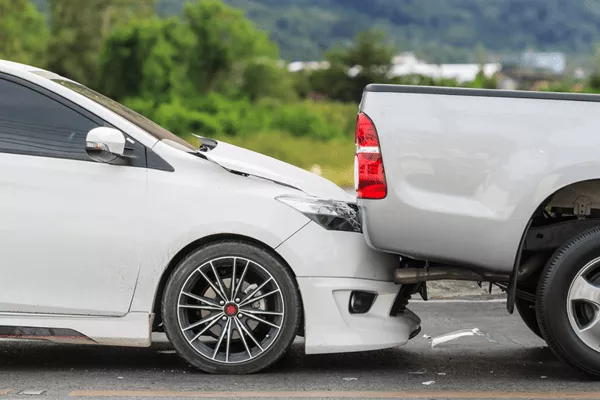
Airbags should only deploy in the event of a collision
>>> Read more: 137,000 units of Honda CR-V 2019 will be recalled globally!
Just a decade ago, we won’t see any of these safety features save for seat belts at the lowest trim variants of car models. Fleet specials of these cars would not have front airbags and instead be treated to the fact that you only have your seat belts to protect you during a crash.
It’s given that seat belts still are the most effective way to minimize injuries if an accident does occur, but safety features stated above are sill necessary and you can't take too many precautions.
All these are well and good but the biggest problem with having so many features on a car is just that, you also have too many features that can break down.
The worst part is if the systems of these Toyota cars have dependencies on other car systems that a single break down can hinder the operation of the other parts.

Safety features don't just stop with seat belts and airbags anymore
Earlier this month Toyota Philippines has issued out a statement to all buyers of the wildly popular Toyota Rush to have their cars checked at any Toyota Dealership due to a faulty ECU setting.
What will happen is that when your car experiences a sudden jolt from our road’s pock-filled streets, the Airbags would automatically deploy, creating a dangerous risk for both the passengers and other cars on the street.
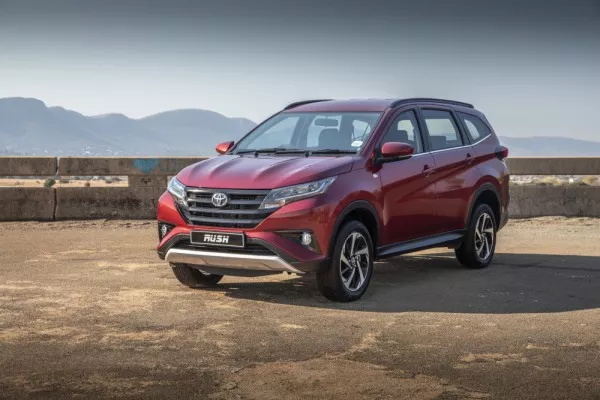
Toyota issues recall advisory for the wildly popular Toyota Rush
Toyota promises a quick fix of 30 minutes for the procedure depending on how busy a service center is at your time of visit. They would be setting up the ECU, reflashing new settings to make sure that the airbags would not deploy themselves in what seems to be normal vehicle operation on our streets.
The sudden and unintended deployment of the airbag has something to do with the localized setting of the ECU which recognizes certain road conditions and misinterprets the data it receives as a collision event.
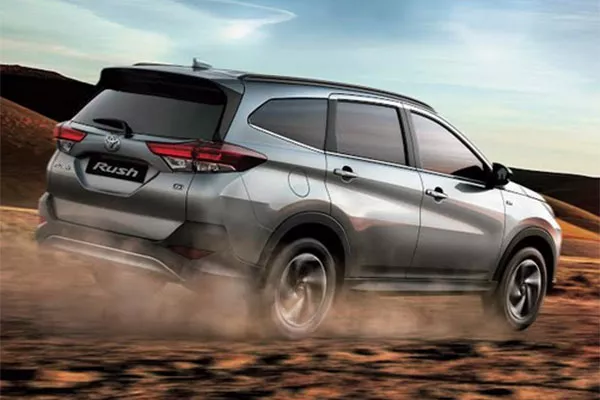
Certain road conditions misinterpret the data the ECU receives as a collision event
Toyota Indonesia has issued out a similar recall announcement and more than 60,000 units of the Toyota Rush were affected by the error. It would most definitely be a jarring experience to be driving along and then hit a simple pothole than have the airbags deploy right into you.
The service advisory states: “As safety is Toyota’s number one priority, we strongly urge our customers to bring the unit to their preferred dealership immediately upon receipt of our notice. While servicing the unit is pending, we urge our customers to take extra precautions when driving on uneven roads."
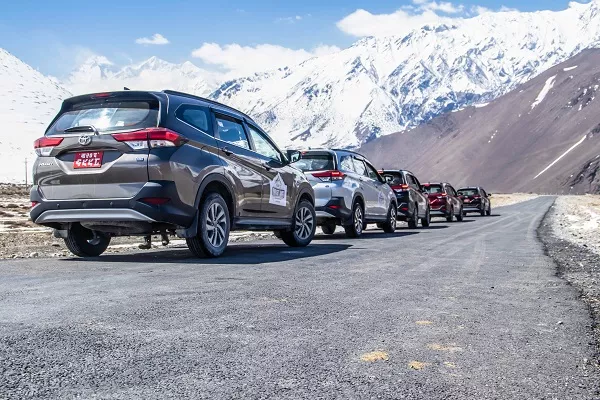
More than 60,000 units were affected by the error in Indonesia
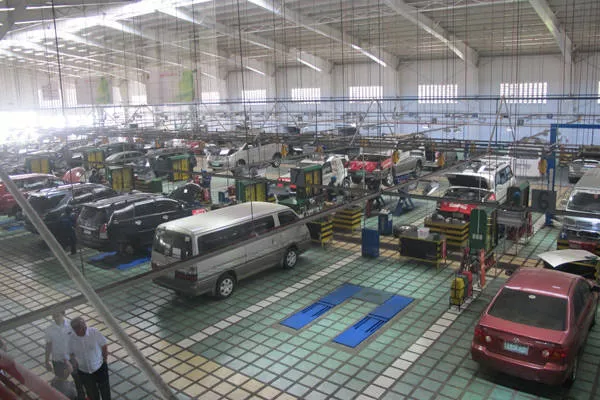
Toyota promises a quick fix of 30 minutes for the procedure
What do you think about this recall from Toyota? Drop us a line with your opinion and as always stay tuned to Philkotse.com for updates, news, and reviews on cars and insights on the car market.
Know more about Toyota Rush 2025

The Toyota Rush 2025 is Toyota Motor Philippines (TMP)’s entry into the local competitive multi-purpose vehicle (MPV) segment. Considering its relatively large size and affordable pricing, the MPV is regarded by some as an entry-level SUV for the Japanese car brand. Toyota Rush Price in the Philippines is P1,208,000 with only one 1.5 G-RS variant. Under the hood, it is powered by a 1.5-liter 2NR-VE inline-4 DOHC gasoline engine that makes 102 hp and 134 Nm of torque. This engine can be connected to a 4-speed automatic transmission. Dimensions-wise, the Rush spans 4,435 mm in length, 1,695 mm in width, and 1,705 mm in height. In the local market, this vehicle from Toyota Philippines competes against the likes of the Mitsubishi Xpander and Honda BR-V.
There are many SUV-like features that the Toyota Rush offers such as a relatively high ground clearance rated at 220 mm and its new seating configuration that makes seven as standard across all variants. It is considered one of the best value for money, especially for those who wish for a relatively affordable family car. In other markets, the Toyota Rush is called the Daihatsu Terios due to the Japanese automaker's partnership with Daihatsu Motor.
>>> New and used Toyota Rush 2025 for sale in the Philippines
Toyota Rush Launch
The updated Toyota Rush was introduced by TMP last November 2020 which now offers a 7-seating configuration as standard. The Japanese carmaker shared that a 7-seater MPV is a favorite family vehicle among Filipinos so it wanted to add a third row of seating for all variants.
In 2022, TMP replaced the top-spec Rush G with the sportier GR-S variant. The updated 7-seater MPV is currently competing against the likes of the Mitsubishi Xpander, Honda BR-V, and Maxus G50.
Toyota Rush Exterior
The Toyota Rush is currently riding on the exterior design of the third-generation Daihatsu Terios. It comes with an SUV-like and more aggressive road presence as it is inspired by the design of its 7-seater midsize SUV sibling, the Toyota Fortuner.
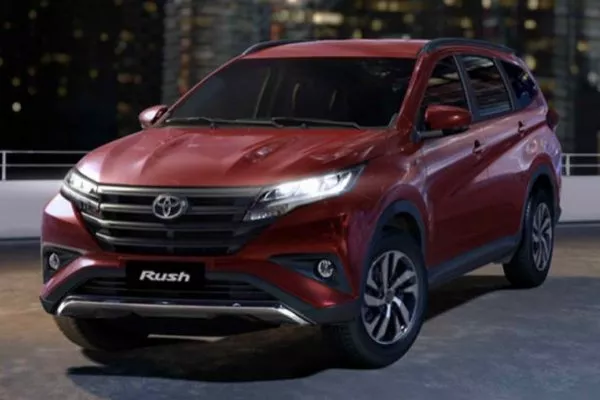
The exterior design of the Toyota Rush is inspired by the Toyota Fortuner
All variants of the Toyota MPV are installed with LED headlights and taillights (with LED guidelines), a rear spoiler, a shark-fin antenna, and more. E variants get chrome radiator grille and 16-inch alloy wheels, while the top-ranging GR-S variant comes with GR-S treatment and 17-inch alloy wheels.
Toyota offers the Rush six color options: White, Bronze Mica Metallic, Dark Red Mica Metallic, Bordeaux Mica, Silver Mica Metallic, and Black Metallic.
Toyota Rush Interior
As said earlier, all variants now come with a 7-seating configuration which should be practical for those who want to own a relatively large car but don’t want to spend a hefty amount of cash. The 50:50 third-row seats can be folded to offer more cargo space.
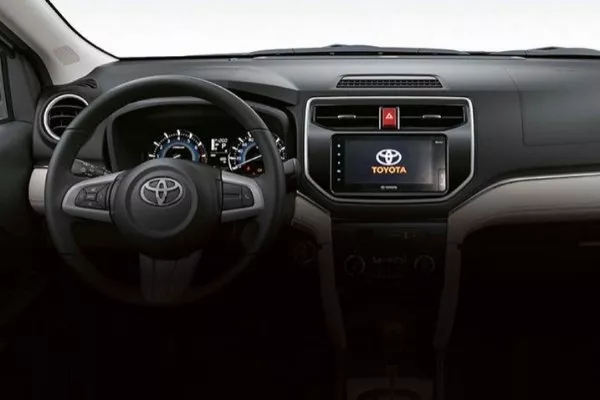
Another notable feature inside the Toyota Rush is the white accents on the doors and dashboard decorated with faux stitches
The interior for the lower E variants is installed with a urethane 3-spoke steering wheel, shift lever, and knob. Meanwhile, the top-ranging GR-S variant benefits from leather materials on the said interior parts and three accessory outlets as compared to just one for E variants.
>>> Get best deals of the Toyota Rush for sale in the Philippines at amazing prices
Technology & Safety Features
The Toyota Rush is installed with a 7-inch infotainment screen across all variants which supports CD/MP3, AUX, USB, Bluetooth, and Weblink Connectivity for iOS/Android. Sounds are sent off to six speakers for E variants, while the top-of-the-line variant gets eight.

Toyota Rush's airbags
As for safety, the updated model still offers the same features such as six airbags, an anti-lock braking system (ABS) with electronic brakeforce distribution (EBD), traction control, hill start assist, emergency stop signal, and ISOFIX tethers. Keyless entry is used for E variants and smart entry is the go-to for the GR-S variant.
Platform & Chassis
The Toyota Rush is designed with a ladder-frame chassis similar to the Toyota Avanza. It is built on the Daihatsu F800, the platform of the current Daihatsu Terios. This platform configuration, including the 220 mm ground clearance, solidifies the model’s reputation as a small yet rugged SUV.
To further improve stiffness, the front suspension is handled by a McPherson Strut, and a four-link suspension for the rear setup. As for the brakes, the 7-seater MPV is installed with disc brakes on the front wheels and drum brakes for the rear wheels.
Engine & Drivetrain
Under the hood, the Toyota Rush is powered by a 1.5-liter 2NR-VE Dual VVT-i gasoline engine that can put up 102 hp and 134 Nm of torque. This is the same engine that the Toyota Avanza and Veloz use.

Powering the Toyota Rush is a 1.5-liter 2NR-VE Dual VVT-I gasoline engine
For the base E variant, it pairs the engine with a 5-speed manual transmission. Meanwhile, the rest of the two variants of the model use a 4-speed automatic transmission. The power is sent to the rear wheels thanks to its rear-wheel-drive (RWD) drivetrain.
>>> Also check out:
- What we'd like to see from an updated Toyota Rush 2020 Philippines
- Sib Duel: Toyota Rush vs Innova MPV Specs Comparison
Toyota Rush 2025 Price List
| Variant | Price |
|---|---|
| Toyota Rush 1.5 GR-S | ₱1,208,000 |
Toyota Rush FAQs
1. Does Toyota Rush Philippines have cruise control?
No, it doesn't. No variants of the Rush come with cruise control.
2. How much will the Toyota Rush 2025?
The Toyota Rush is priced at P1,202,000.
3. What engine will the Toyota Rush 2025 use?
Toyota Rush is operated by a gasoline engine (1.5L) with a maximum output of 102 horsepower and 134 Nm.
4. What is the length of the Toyota Rush Philippines?
The length of the Toyota Rush is 4335mm, while the width is 1695mm.
5. Is the Toyota Rush a reliable car?
Yes, it absolutely is. The Toyota Rush is one of the best-selling SUVs in the Philippines market because it offers a perfect combination of performance, style, and comfort.
₱ 1,012,000 - ₱ 1,176,000
ExploreRecent posts
- What to do when your car is recalled? Aug 16, 2022
- 7 reasons why the Toyota Rush is a good buy in 2019 Sep 24, 2020
- Latest Toyota Rush Price Philippines 2025 May 19, 2020
- 7-seater Toyota Rush 2018 officially comes out for Philippine market Oct 23, 2020
















